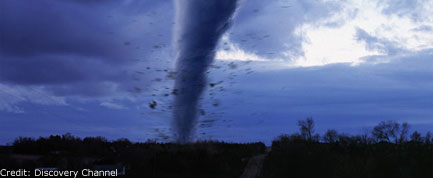
James Abbot is not having a good day. A massive thunderstorm called a supercell is heading towards Dallas, Texas and Abbot, a member of the city's Emergency Management team, has just made the difficult decision to sound the city's tornado-warning sirens.
The supercell spawns several small tornadoes, and then after a brief lull, swells to massive size and unleashes a mega-tornado with wind speeds of over 350 mph. The 1.5-mile-wide twister promises to be the most devastating in history and it's heading straight for downtown Dallas, where Abbot's wife and child are stranded.
This is the setup for "Super Tornado," the first episode of a new Discovery Channel television series called "Perfect Disaster."
The series examines what might happen if some of Nature's most destructive storms were unleashed on some of the world's most populous cities.
Each catastrophe is presented as a mini-movie, complete with actors and fictional storylines, but unlike similar Hollywood creations, each episode is peppered with expert scientific commentary and slick computer animations explaining the science behind the storms.
The series' tagline is "It may not happen tomorrow, but it is scientific prediction."
Each episode takes a natural disaster and imagines what might happen if it were ratcheted up a notch to become the "perfect storm" of its type. Tornadoes become mega-tornadoes that reduce entire cities to rubble and solar storms are so powerful they can generate global blackouts that last for years.
Get the world’s most fascinating discoveries delivered straight to your inbox.
The special effects in each episode are top-notch and the acting is generally good. If viewers were to tune in during a part that didn't involve an educational animation or scientific commentators—like Alan Moller from the National Weather Service explaining the science of tornadoes— they might be fooled into thinking they were watching a typical Hollywood disaster flick.
What sets the series apart from movies like "The Day After Tomorrow" and "Armageddon," however, is the care taken to be scientifically accurate. When the Sun unleashes a massive stream of charged particles that threatens to black out the entire globe in "Solar Storm," the series' second episode, humanity doesn't send a ragtag crew of oil rig workers up in a space shuttle to save the day.
The storyline of "Solar Storm" is this: It's the year 2011. Everyone is talking on fancy video cellphones and China has a space station in Earth orbit. A fireball streaks down to Earth and lands in a Brooklyn cemetery. When a cop moves in to investigate, he finds that it's not a downed UFO or fallen space rock, but a fried satellite.
Scientists link this strange occurrence to strong solar storms in space. The Sun has reached its solar maximum, a turbulent period in its sunspot cycle, and it has unleashed a monster solar flare and massive amounts of radiation.
The worst is still to come though. NASA's SOHO satellite has just detected a coronal mass ejection, or CME, three times stronger than anything scientists have ever seen. If it strikes Earth, the CME will easily break through the magnetosphere, the Earth's natural shield against solar storms, and could cause global blackouts that last for years. In the midst of all this, the Mayor of New York has to decide whether to permit a deliberate blackout in Brooklyn—something never done before—to save sensitive equipment in power plants when the CME hits.
The series' weakest point is its storylines. With each episode being only an hour long and including expert commentary as well as educational animations, little time is left to flesh out any of the characters or stories. However, this is a small complaint for a series that manages to be both entertaining as well as scientifically on the mark.
The series also includes: a super typhoon bearing down on Hong Kong; a mega flood engulfing London; a fire storm blazing up Sydney; and an ice storm that brings Montreal to a standstill.
The first two episodes of "Perfect Disaster" air Sunday, March 19 at 9 p.m. on both coasts.


